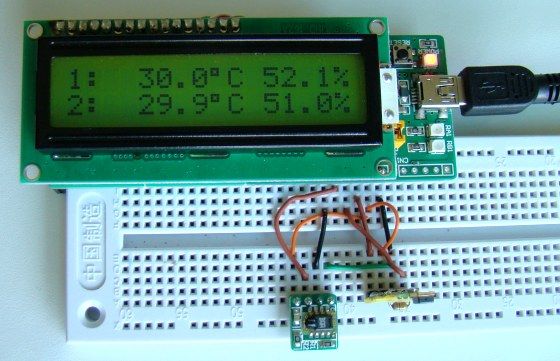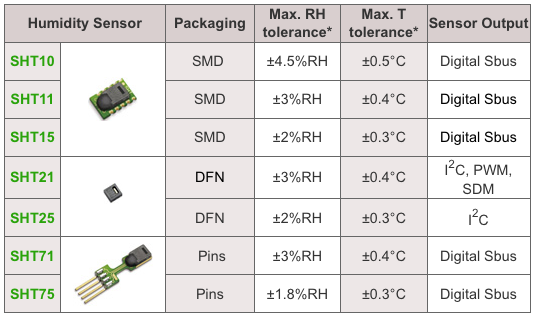Summary of Humidity and temperature measurements with Sensirion’s SHT1x/SHT7x sensors using PIC18F2550 (Part 1)
This article discusses the use of Sensirion's SHT11 and SHT75 digital sensors for measuring temperature and relative humidity, which are vital for human comfort and environmental control. It explains the sensor technology, communication protocol, and integration with a PIC18F2550 microcontroller. Both sensors provide fully calibrated digital output via a two-wire serial interface, though they are not standard I2C. The article also highlights differences, such as the presence of onboard pull-up resistors on the SHT11 module and their absence on the SHT75, affecting implementation considerations.
Parts used in the Sensirion SHT1x/SHT7x Temperature and Humidity Measurement Project:
- Sensirion SHT11 sensor module (mikroElektronika version with pull-up resistors)
- Sensirion SHT75 sensor module (without pull-up resistors)
- PIC18F2550 microcontroller
- Pull-up resistors (external, for SHT75 SDA line)
- Microcontroller programmer/compiler (mikroC PRO for PIC)
- Prototyping board (for sensor soldering and connections)
Temperature and relative humidity are two very important ambient parameters that are directly related to human comfort. Monitoring these factors becomes even more crucial in various applications such as environmental control systems and indoor climate management. Integrating sensors like the Sensirion SHT1x/SHT7x can provide precise measurements, ensuring optimal conditions for occupants while also enabling efficient energy usage. Sometimes, you may be able to bear higher temperatures, if there is a lower relative humidity, such as in hot and dry desert-like environment. However, being in a humid place with not very high temperature may make you feel like melting. This is because if there is high relative humidity, sweat from our body will evaporate less into the air and we feel much hotter than the actual temperature. Humidifiers and dehumidifiers help to keep indoor humidity at a comfortable level. Today we will discuss about Sensirion’s SHT series of digital sensors, more specifically SHT11 and SHT75, which are capable of measuring both temperature and relative humidity and provide fully calibrated digital outputs. We will interface both the sensors to PIC18F2550 microcontroller and compare the two sets of measurements to see the consistency between the two sensors. This tutorial is divided into two parts. The first part will cover all the details regarding the sensors, including their specification, interface, and communication protocol. The second part will be more focussed on the circuit diagram, implementation of the communication protocol with PICMicro, and the results.
Theory
Sensirion offers multiple SHT series of digital sensors for measuring both relative humidity and temperature. The temperature is measured using a band-gap sensor, whereas the humidity sensor is capacitive; which means the presence of moisture in air changes the dielectric constant of the material in between the two plates of a parallel-plate capacitor, and hence varies the capacitance. The required signal conditioning, analog-to-digital conversion, and digital interface circuitries are all integrated onto the sensor chip. The various SHT series sensors have different levels of accuracy for humidity and temperature measurements, as described below.
SHT1x, 2x, and 7x series of humidity sensors (Source: http://www.sensirion.com)
SHT1x are available in surface mount type whereas SHT7x are supplied with four pins which allows easy connection. The SHT11 and SHT75 sensors both provide fully calibrated digital outputs that can be read through a two-wire (SDA for data and SCK for clock) serial interface which looks like I2C but actually it is not compatible with I2C. An external pull-up resistor is required to pull the signal high on the SDA line. However, the SCK line could be driven without any pull-up resistor. The signaling detail of the serial bus is described in the datasheet, which we will implement for PIC18F2550 microcontroller using mikroC pro for PIC compiler. The operating range of both the sensors is 0 to 100% for relative humidity, and -40.0 to 123.8 °C for temperature. The sensor consumes 3 mW power during measurement, and 5 μW, while in sleep mode.
The SHT11 module that I have got is from mikroElektronika. The sensor (SMD) is soldered on a tiny proto board with all the four pins accessible through a standard 0.1 inch spacing male header. The board comes with pull-up resistors connected to both SDA and SCK lines. One concern in this type of arrangement is the heat dissipated by the pull-up resistors could affect the measurements if the resistors and the sensor are close in the board. We will discuss about this issue later too. The SHT75 module from Sensirion, however, does not include any pull-up resistor for SDA line and therefore must be included externally.
For more detial: Humidity and temperature measurements with Sensirion’s SHT1x/SHT7x sensors using PIC18F2550 (Part 1)


